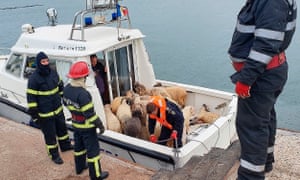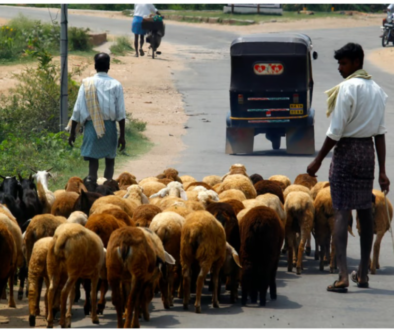‘A whole sheep for £18’: how live exports are hurting farmers in Romania
Gheorghe Dănulețiu, also known as Ghiță Ciobanul (Ghiță the shepherd), has more than 500,000 followers on Facebook after he featured in an advertising campaign that went viral, but he leads the modest life of a traditional shepherd.
Looking after 1,500 sheep in western Romania, Dănulețiu’s life changes with the seasons. During lambing in spring, he barely sleeps four hours a night while in winter he leads his sheep in a three- to four-week journey from the mountains down to graze in the valleys.
Even when the temperature drops below -30C(-22F), Dănulețiu sleeps next to his animals, wrapped in his sheepskin under the starry sky and ready to protect his flock in case of a wolf attack.
“I inherited this [role] from my father – who had a few hundred sheep – but I also love it, I love animals,” Dănulețiu says.
However, like all Romanian shepherds with small and medium-sized flocks, Dănulețiu is struggling in a market dominated by a few live animal exporters, big farmers and hypermarkets.
“The sheep trade has become a mockery,” he says. “We sell a sheep for 100 Romanian leu (about £18). I can’t afford to pay good salaries and I can’t find workers any more – young people see that it’s all going downhill. I have the impression that this is political, that they’re trying to destroy the sector.”
Live export has become a crucial industry for Romania. In November the world watched in horror as more than 14,000 sheep drowned in the Black Sea port of Midia on their way to Saudi Arabia.
Until then few people – even in Romania – had been aware of the scale of the live export trade. In fact in 2018, Romania exported animals worth €357m (£305m), making it Europe’s biggest exporter of live animals, and the tenth largest exporter of live cattle globally.
The current arrangement dates back to the collapse of Nicolae Ceaușescu’s regime in the late 1980s, when Middle Eastern companies started taking over the Romanian live export market. Until the 2000s live exports went primarily to southern European countries such as Greece and Croatia, but in the 2010s Jordan, Libya, Lebanon and Israel also became valuable markets.
Romania does not have the slaughterhouses to process the meat it needs. Although it has received subsidies totalling 26 billion euros since joining the EU in 2007, they are oriented towards production rather than building the processing systems that the country so urgently needs. So, despite the number of animals it exports, it has to import meats and other processed products.
Like most sheep and goat farmers in Romania, Dănulețiu has no option but to sell his animals to private collection centres for as little as £18 per head.

The export firms sell these animals for 10 times that price in the Middle East and north Africa, although “the animals’ prices vary like stock prices”, according to a Lebanese businessman at one of the biggest agricultural exporters in Romania.
The farmers are trapped in an impossible situation. Despite the deep roots of shepherding in Romania, lamb is consumed only at Easter. Moreover, the vast majority of sheep are of a mixed breed – țurcana – which are kept for milk as well as meat, making the meat less desirable on the European market.
The financial realities of raising sheep mean there’s little profit in it and many shepherds are getting out.
The situation is similar for cattle farmers in Romania. Sebastian Ile, who has a herd of 28 Angus cows, is trying to increase his negotiating power with exporting firms by forming a cooperative with eight other farmers. This means he can sell at a higher price per kilo – €2.5 compared to €1.8 – which is how much smaller farmers receive. But his ambitions go further than that.
“Two years ago, we started off a big project to do the whole chain – from raising animals to processing and selling meat. But it will take a long time and we will need EU or national funds to bring the project to completion,” he says.
Providing facilities for humane slaughter in countries of origin is critical, says Gabriel Paun of Animals International. Based in Romania, he has been investigating the animal export trade for several years, and gives first-hand accounts of the animals’ long journeys in sweltering heat, as well as the brutal nature of their slaughter in the Middle East.
“Not only is this extremely cruel, but there’s also a solution that would please 99.99% of people, that is, the consumers and the farmers in the importing countries, as well as the Romanian farmers,” Paun explains. “The only ones who would not benefit from this solution are the exporting firms.”
That solution involves replacing live animal exports with meat and carcass exports, both of which Romanian and European policymakers are now discussing. In December the European Union called for an update on current legislation on animal transport over long distances, as well as discussions on the sustainability of live transport versus meat trade. At the moment, EU regulations dating from 2005 make EU countries responsible for exported animals only on EU territory, rather than until they reach their destination.
The Romanian government has convened an agriculture commission to draft a new law regarding live animal exports, which would make Romania responsible for the state of the animals not only until the point of export, but all the way to the animals’ destination. If adopted, the law would be a first for the EU.
The new law would also make it compulsory for ships to have a vet on board. Inspired by the legal framework for slaughterhouses in the UK, some members of the commission suggested CCTV to monitor the animals until they reach their destination.
“This is a definite positive step in the right direction,” says Mary Pana, president of farmers’ union Acebop, which is part of the agriculture commission. The new proposal is aligned with Acebop’s current main priority – animal welfare.
Within five years, Pana also hopes Romania can move towards exporting meat rather than live animals. “In order to do that, we want the government to approve the construction of two or three big capacity abattoirs by the seaside, with freezer storage, and then a large part of the problems will be solved,” she says.



